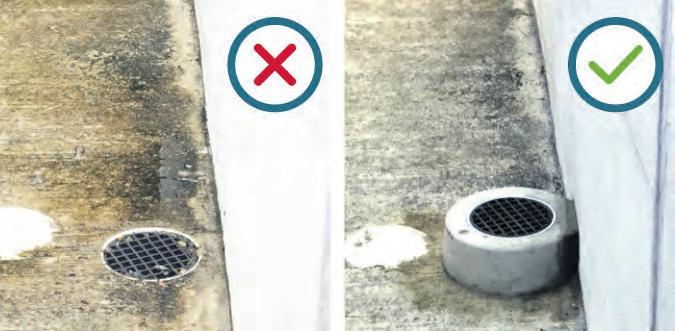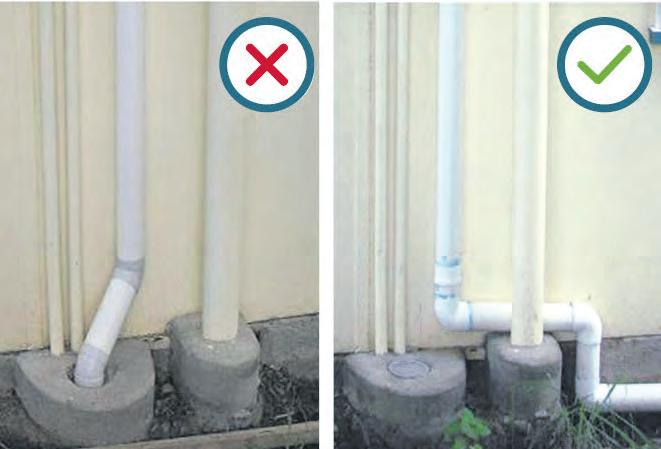
2 minute read
Keep stormwater out of your sewer pipes
Property owners can prevent nasty sewage overflows by checking 2 things around their homes.
Water and Wastewater operations manager Brie Jowett said last year’s very high rainfall drew attention to the need for everyone to ensure their downpipes do not connect to sewer pipes and their overflow relief gullies are compliant.
Advertisement
“You can find your overflow relief gully outside, usually near your toilet, laundry or kitchen,” Mrs Jowett said.
“It should be around 75 mm above the ground that surrounds it. If it’s not, stormwater can more easily overload your sewer pipes and cause a sewage overflow.
“Also make sure your gully is not covered up. We typically see leaves, mats and pot plants on top but sometimes we see gullies completely covered by concrete or paving. Any type of covering can stop your gully from doing its job and sewage might overflow inside your home.
“And if you have a rainwater tank, make sure it doesn’t overflow to your sewer pipes.”
Mrs Jowett said sewer pipes and the larger wastewater network weren’t designed to drain stormwater.
“The network is built to transfer wastewater from toilets, sinks and drains to our wastewater treatment plants,” she said.
“It’s hard to avoid some stormwater from entering, so the network can generally pass 5 to 7 times its normal, dry weather volume. Yet during downpours some sections have been carrying up to 20 times that volume.
“This overloads the network, causing sewage overflows at homes, backyards, businesses, streets and waterways. Overflows are serious health and environmental concerns and clean-ups are costly and far from pleasant.”
Throughout the year, Council crews work hard to reduce the amount of stormwater that enters the wastewater network.
“Our workers identify stormwater entry points through visual inspections, smoke testing, non-toxic die testing and camera inspections,” Mrs Jowett said. “Sometimes, we detect problems in our side of the wastewater network, which is seeing us reline older sewer pipes and repair leaky manholes.
“If we find a problem at a private property, we will send the owner a letter letting them know about the problem and advising them how to fix it. While we can issue penalties for not fixing these problems, we prefer to work with property owners to provide them with all the information they need.”
Go to tweed.nsw.gov.au/no-stormwater-in-sewers to find out more.
Development application determinations
Notification of development application determinations for the purposes of Section 4.59 of the Environmental Planning and Assessment Act 1979 (as amended).
Application details
Approved
DA22/0419 – Secondary dwelling and carport
Lot 3 DP 549087, No. 1 Peter Street, Banora Point
DA22/0585 – Alterations and additions to existing dwelling including carport and gate house within front building line
Lot 206 DP 261796, No. 76 Bosun Boulevard, Banora Point
DA22/0191 – Boundary adjustment
Lot 32 DP 1085109, Lot 33 DP 1085109, Marana Street, Bilambil Heights
DA22/0514 – Alterations and additions to existing dwelling including garage, carport and pool
Lot 574 DP 217268, No. 15 Poplar Avenue, Bogangar
DA22/0537 – Carport within the front building line
Lot 5 DP 1052380, No. 35 Reef Water Circuit, Bogangar
DA23/0005 – Two storey dwelling with attached garage and inground swimming pool
Lot 23 DP 1286551, No. 16 Kanooka Crescent, Bogangar
DA23/0077 – Carport
Lot 59 DP 859730, No. 61 Hunter Street, Burringbar
DA22/0322 – Alterations and additions to existing detached dual occupancy (unit 1) including a carport, swimming pool and conversion of the garage to a living area
Lot 1 SP 98974, No. 41A Victoria Avenue, Pottsville
DA22/0589 – Alterations and additions to existing dwelling including inground pool and alterations to existing front fence
Lot 58 DP 221408, No. 35 Elanora Avenue, Pottsville
Top, make sure your overflow relief gully is compliant, and (above) check that your downpipes do not connect to your sewer pipes. Images courtesy of Unitywater.











